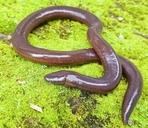|
Ichthyophis benjii Lalremsanga, Purkayastha, Biakzuala, Mathipi, Muansanga & Hmar, 2021
Benji’s Caecilian | family: Ichthyophiidae genus: Ichthyophis |
| Species Description: Lalremsanga HT, Purkayastha J, Biakzuala L, Vabeiryureilai M, Murasanga L, Hmar GZ. 2021. A new striped species of Ichthyophis Fitzinger, 1826 (Amphibia: Gymnophiona: Ichthyophiidae) from Mizoram, northeast India. Amphibian & Reptile Conservation 15(2) [Taxonomy Section]: 198–209 (e288). | |
 © 2021 Hmar Tlawmte Lalremsanga (1 of 3) |
|
|
|
Description DIAGNOSIS: Within the group of striped congeners, I. benjii has a noticeably less prominent pale yellow lateral stripe above a darker ventrolateral longitudinal stripe bordering the venter on each side. It can be differentiated from Ichthyophis tricolor and Ichthyophis multicolor due to the much higher dorsal annular groove count of 385 - 422 and ventral annular groove count of 383 - 423 (Laremsanga et al. 2021). COLORATION: In life, the dorsum is a dark brownish-grey, the venter is reddish-grey, and the narrow irregular faint lateral stripes are a dull yellow. A thin midventral line from the anterior of the corners of the mouth across the first collar to the second nuchal groove that is pale yellow. With the exception of the areas crossing the faint lateral stripes and the venter, annular grooves appear to be mostly paler than the surrounding skin. The tip of the tail also appears pale (Laremsanga et al. 2021). In preservation, the dorsum is brownish-grey and is more chocolate brown where the stratum corneum is absent. The tentacular papillus and snout tip are pale. The eye is surrounded by a narrow whitish ring and covered by translucent skin. There is no presence of moustache-like stripes between the snout tip and tentacular apertures. The venter is a much paler brownish-grey. Around the cloaca, there is a pale disc. The upper and lower jaws have pale lines. Beginning from right behind the corners of the mouth, I. benjii has irregular, faint, lateral yellow stripes that extend to the level of the posterior of the vent, without touching the cloacal disc. The stripe breaks at several points. Stripes are also either absent or barely visible on the ventral side of the collars and are patchy in the trunk region (Laremsanga et al. 2021). VARIATION: Some of the specimens were much larger than the holotype and several were less elongate. The specimen with the highest dorsal annular groove count was also the only specimen to have a ventral annular groove count larger than the dorsal count. The width of the stripe at midbody doesn’t appear to grow as fast as the width of the body and the tail appears to lengthen slower than the head during development, without correlation to total length. Specimens had 118 to 124 vertebrae (Laremsanga et al. 2021). Distribution and Habitat Country distribution from AmphibiaWeb's database: India
Life History, Abundance, Activity, and Special Behaviors One specimen had a small freshwater shrimp in its mouth, suggesting that prey includes freshwater macroarthropods (Laremsanga et al. 2021). Sympatric species of caecilians include Ichthyophis khumhzi, I. moustakius, and I. multicolor and sympatric frogs include Duttaphrynus melanostictus, Fejervarya multistriata, Minnervarya asmati, Megophrys serchhipii, Polypedates teraiensis, Zhangixalus suffry, and Zhangixalus smaragdinus (Laremsanga et al. 2021). Trends and Threats Relation to Humans Possible reasons for amphibian decline Intentional mortality (over-harvesting, pet trade or collecting) Comments PHYLOGENETIC RELATIONSHIPS: The ten species of Ichthyophis in the eight states of northeast India can be divided into a single unstriped form and nine striped forms, including I. benjii. Based on Maximum Likelihood and Bayesian analyses of 16s mtDNA I. benjii is a sister taxon to the I. multicolor, however, this relationship is not strongly supported (Laremsanga et al. 2021). ETYMOLOGY: The species epithet “benjii” is a dedication to the nephew, Benjamin Lalremsanga (1988–2020), of lead author, Hmar Tlawmte Lalremsanga. Benjamin Lalremsanga actively assisted the authors in herpetological research (Laremsanga et al. 2021).
References
Lalremsanga, HT, Purkayastha, J, Biakzuala, L, Vabeiryureilai, M, Murasanga, L, Hmar, GZ. (2021). "A new striped species of Ichthyophis Fitzinger, 1826 (Amphibia: Gymnophiona: Ichthyophiidae) from Mizoram, northeast India." Amphibian & Reptile Conservation 15(2), 198–209 (e288). [link] Originally submitted by: Olivia Dale (2022-12-20) Description by: Olivia Dale (updated 2022-12-20)
Distribution by: Olivia Dale (updated 2022-12-20)
Life history by: Olivia Dale (updated 2022-12-20)
Trends and threats by: Olivia Dale (updated 2022-12-20)
Relation to humans by: Olivia Dale (updated 2022-12-20)
Comments by: Olivia Dale (updated 2022-12-20)
Edited by: Ann T. Chang (2022-12-20) Species Account Citation: AmphibiaWeb 2022 Ichthyophis benjii: Benji’s Caecilian <https://amphibiaweb.org/species/9455> University of California, Berkeley, CA, USA. Accessed Apr 19, 2024.
Feedback or comments about this page.
Citation: AmphibiaWeb. 2024. <https://amphibiaweb.org> University of California, Berkeley, CA, USA. Accessed 19 Apr 2024. AmphibiaWeb's policy on data use. |


 Map of Life
Map of Life